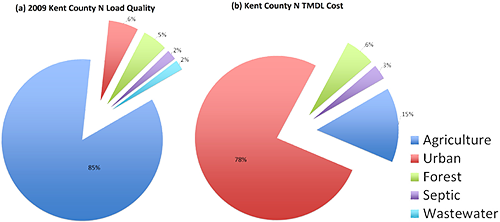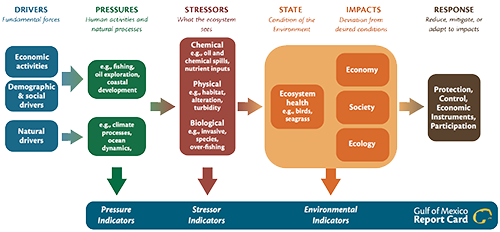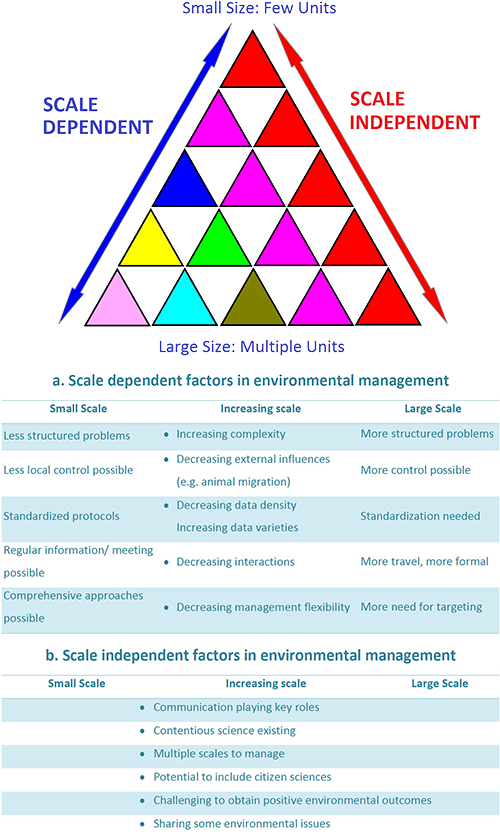Change of science and management in ecosystems along size gradient
Long Jiang, Yini Shangguan, Miaohua Mao ·How does ecosystem size affect different environmental management actions? To some extent, a difference in the system scale means variety in the environmental status, research directions, public attention, and management efforts. Therefore, the way of approaching certain management objectives varies based on different size scales. In this blog, we compare five cases along an increasing watershed size gradient (Fig. 1): the Chester River, South Florida, the San Francisco Bay/Delta, the Great Barrier Reef, and the Gulf of Mexico.

1. A glimpse of each ecosystem
The Chester River is a major tributary on the eastern shore of the Chesapeake Bay. Like some other rivers around the Bay, overloading of nutrients tends to be one of the most troublesome environmental problems, resulting in low dissolved oxygen, algal blooms, fish kills, etc. As we can see from Fig. 2-a, nitrogen comes mainly from agriculture (corn, soybean and poultry) in the watershed of the Chester River. Efforts are taken every year to monitor the water quality and restore the ecosystem in the river; the Chester Tester Program provides local environmental report cards every year [1]. However, due to the relatively long time lag and the imbalance between economic benefits and environmental effects (Fig. 2-b), little significant improvement has been shown in the monitoring results [2], even though some sound measures have been taken such as cover crops, oysters and nutrition reduction credits [3,4]. Trust and communication are always important to gain significant nutrient reduction from farms.

South Florida is a modified watershed due to the development of agriculture and urbanization. Other than hydrological modification, invasive species and climate change (sea level rise) have also affected the environmental and ecological balance of Florida Bay. Similar to the Chester River, eutrophication and algal blooms have threatened the habitat. Seagrass die-off, phytoplankton blooms, sponge mortality and lobster declines [5] occurred in the late 1980s and early 1990s. These substantial ecological changes have altered the community structure and become contentious scientific problems. A restoration plan has been proposed to protect the coral reefs around the South Florida Bay. Massive funds have also been poured in to improve the water resource management.
As with the case of South Florida, San Francisco Bay/Delta has also been undergoing hydrologic modification, invasive species and algal blooms. Monitoring systems have been adopted to detect environmental changes, providing insights into the underlying causes and prompting migration and adaptation policies. The San Francisco Bay/Delta has been a well-studied system. Additionally, plenty of long-term monitoring data have [6] been available for a variety of research projects.
The Great Barrier Reef is vulnerable to climate change and human activities. Agricultural nutrient runoff and point source pollution have caused severe damage to the coral reef. Climate change (global warming, ocean acidification and storm surge) has been affecting the coral reef ecosystem on a large scale. Due to its great ecological, social, and economic value, Reef Water Quality Protection Plan has been sparing no effort to protect the Great Barrier Reef [7]. Collaboration of multiple regions, agencies, research groups and industries has been expected to better protect and monitor the reef.
The Gulf of Mexico is the largest ecosystem in the case study. Human activities have played a significant part in the health of the Gulf. Over fishing, nutrient overloading and oil spills have been the primary anthropogenic pressures on the Gulf of Mexico. Moreover, frequent hurricanes have brought strong oscillation to the ecosystem. The Gulf of Mexico Report Card (Fig. 3) has been launched to assess and represent the environmental health of the Gulf [8].

2. Scale dependent factors in environmental management
Based on the five case studies, scale dependent factors could explain the reasons for different management strategies (see Fig. 4-a). For small ecosystems, environmental problems are relatively simple; for example, the nutrient overloading problem in the Chester River is not as complex as that in the Gulf of Mexico. In general, there are much data available in simple ecosystems such as the Chester River and the San Francisco Bay/Delta. Besides, management of small systems often involves more local negotiation with higher flexibility compared to the multiple-level communication of large systems.

However, in terms of small size ecosystems, there might be some scale mismatch problems. For instance, managers of the Chester River might have to balance local efforts with the whole Chesapeake Bay Program. Similarly, South Florida receives significant and sometimes diverse concerns from state and federal management actions.
3. Scale independent factors in environmental management
In spite of the significant differences, environmental management of different scales has a lot in common (Fig. 4-b). Communication between stakeholders, scientists, and managers, is of vital importance. Just like the seagrass die-off and algal bloom issues in South Florida Bay, there might always be contentious scientific problems, which are challenging to managers regardless of system size. Environmental managers need to deal with various levels of government and all natural gradients. What can be learned from the report cards of these cases is that data collection, analysis and interpretation matter in the effectiveness of information delivery. Moreover, it is not easy to reverse degradation in all scales from the Chester River to the Gulf of Mexico.
The five cases have a variety of environmental problems, but share some common issues. Almost all of them show some noted declines in specific species such as seagrass, coral or fish. Some of these declines result from biological competition such as invasive species and harmful algal blooms. In all five cases, water quality is greatly impacted by runoff of sediments, nutrients or toxicants. The impact of climate change, which is seldom being tracked, is increasing with time especially in such relatively large ecosystems as the Great Barrier Reef and the Gulf of Mexico.
4. Different scale, different ecosystem, different management
With the increase of ecosystem size, multiple units and levels were added to the complexity of environmental managements. (Fig. 4) For example, the Great Barrier Reef Report Card involves the collaboration of several departments of Australian and Queensland government, regional natural resource management bodies, industry groups and research institutes; while the Chester River Report Card is mainly in the charge of the Chester River Association. However, there are some similar measures taken in both cases to control the nutrient budget, such as fertilizer reduction, sewage treatment and turbidity control. Therefore, when dealing with ecosystems of different scales, scientists, stakeholders and environmental managers should keep similarities and differences in mind to develop a sound and wise strategy.

References
- Chester River Association
- Chester River Report Card 2007-2011
- UMCES, 2010 Trusted Fund, Water Quality Monitoring Strategy
- Boynton W. et al. (2010) Corsica River Estuary Restoration Saga: Data, Analysis and Lessons Learned
- Butler IV M.J. et al. (1995) Cascading disturbance in Florida Bay, USA: cyanobacteria blooms, sponge mortality, and implications for juvenile spiny lobsters Panulirus argus. Mar Ecol Prog Ser. 129: 119-125
- Cloern J.E. et al. (2012) Drivers of Change in Estuarine-Coastal Ecosystems: Discoveries from Four Decades of Study in San Francisco Bay. Reviews of Geophysics. 50 (4): 1-33
- Great Barrier Reef Report Card Summary - 2009 Baseline
- Gulf of Mexico Report Card Team. A vision for the Gulf of Mexico Report Card
Authors
Long Jiang, Yini Shangguan, Miaohua Mao
Next Post > Top ten conceptual diagrams: Seagrasses, streams, eco-rhythms
Comments
-
Melissa D. 13 years ago
I like the flow and you got a lot of complicated information in there.

